Sustainable Practice and Operations Management for Fonterra
VerifiedAdded on 2023/06/15
|18
|4451
|136
AI Summary
This study explores sustainable practices and operations management for Fonterra, a famous dairy organisation. It discusses external trends and challenges faced by Fonterra and its strengths and weaknesses in responding to them. It also highlights the impact of climate change on Fonterra and its vision for future growth.
Contribute Materials
Your contribution can guide someone’s learning journey. Share your
documents today.
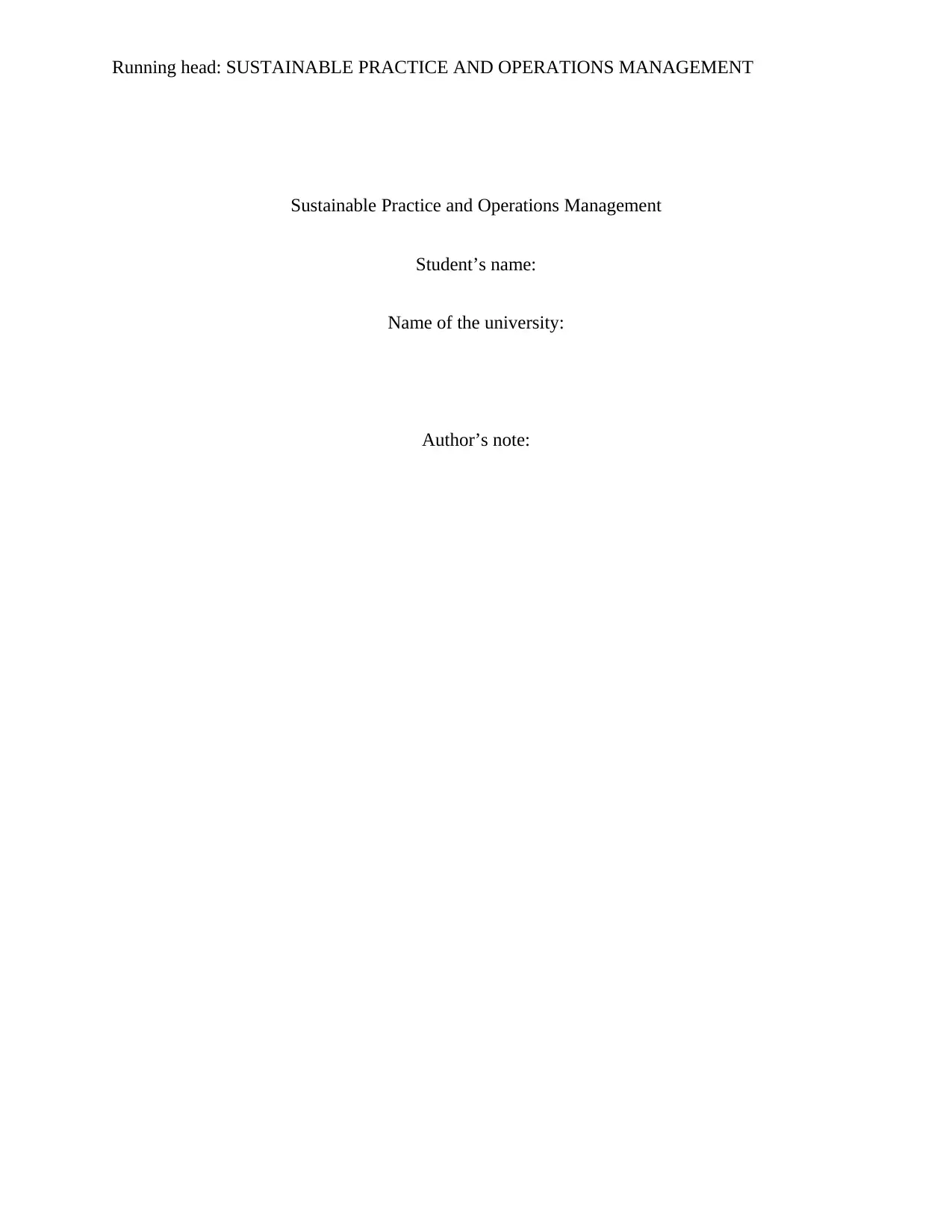
Running head: SUSTAINABLE PRACTICE AND OPERATIONS MANAGEMENT
Sustainable Practice and Operations Management
Student’s name:
Name of the university:
Author’s note:
Sustainable Practice and Operations Management
Student’s name:
Name of the university:
Author’s note:
Secure Best Marks with AI Grader
Need help grading? Try our AI Grader for instant feedback on your assignments.
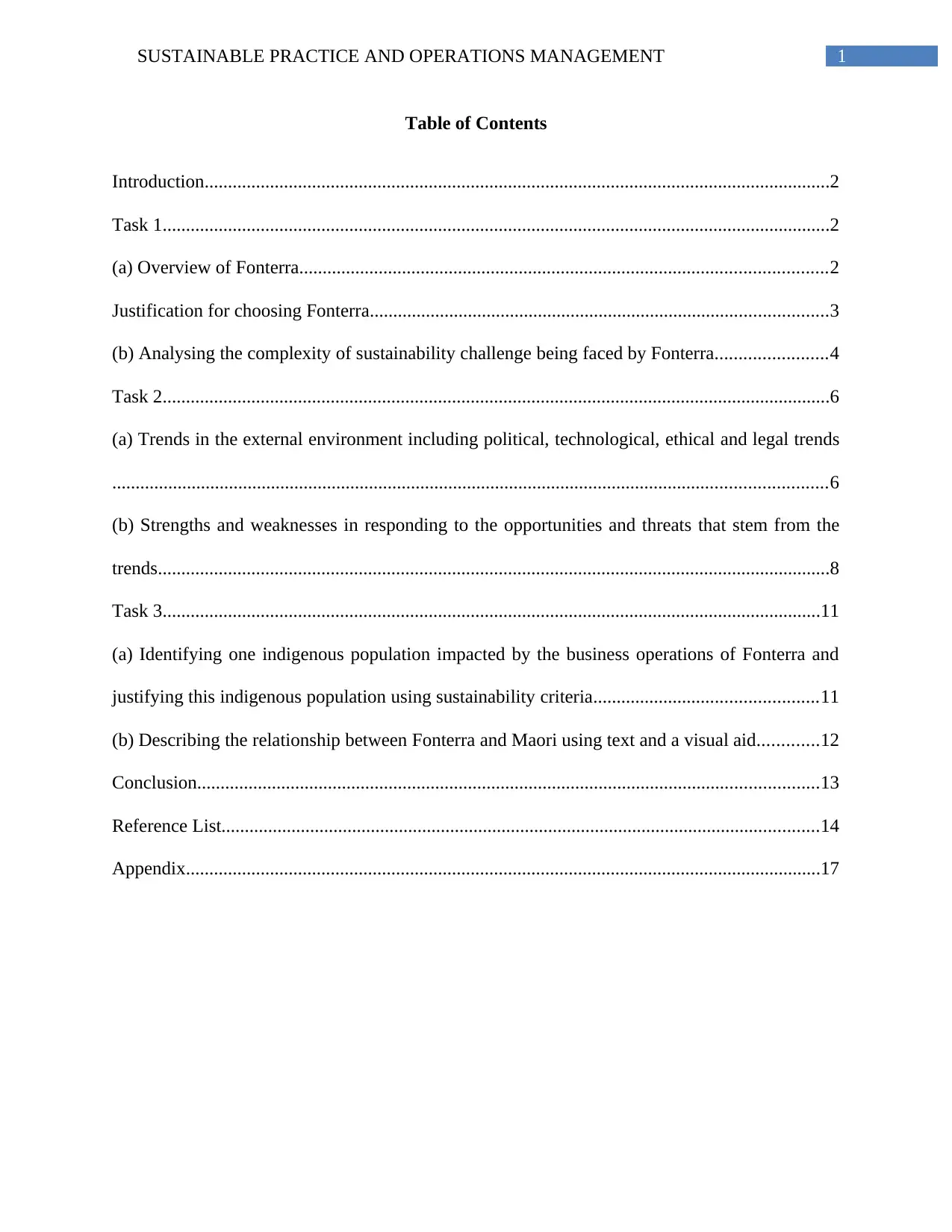
1SUSTAINABLE PRACTICE AND OPERATIONS MANAGEMENT
Table of Contents
Introduction......................................................................................................................................2
Task 1...............................................................................................................................................2
(a) Overview of Fonterra.................................................................................................................2
Justification for choosing Fonterra..................................................................................................3
(b) Analysing the complexity of sustainability challenge being faced by Fonterra........................4
Task 2...............................................................................................................................................6
(a) Trends in the external environment including political, technological, ethical and legal trends
.........................................................................................................................................................6
(b) Strengths and weaknesses in responding to the opportunities and threats that stem from the
trends................................................................................................................................................8
Task 3.............................................................................................................................................11
(a) Identifying one indigenous population impacted by the business operations of Fonterra and
justifying this indigenous population using sustainability criteria................................................11
(b) Describing the relationship between Fonterra and Maori using text and a visual aid.............12
Conclusion.....................................................................................................................................13
Reference List................................................................................................................................14
Appendix........................................................................................................................................17
Table of Contents
Introduction......................................................................................................................................2
Task 1...............................................................................................................................................2
(a) Overview of Fonterra.................................................................................................................2
Justification for choosing Fonterra..................................................................................................3
(b) Analysing the complexity of sustainability challenge being faced by Fonterra........................4
Task 2...............................................................................................................................................6
(a) Trends in the external environment including political, technological, ethical and legal trends
.........................................................................................................................................................6
(b) Strengths and weaknesses in responding to the opportunities and threats that stem from the
trends................................................................................................................................................8
Task 3.............................................................................................................................................11
(a) Identifying one indigenous population impacted by the business operations of Fonterra and
justifying this indigenous population using sustainability criteria................................................11
(b) Describing the relationship between Fonterra and Maori using text and a visual aid.............12
Conclusion.....................................................................................................................................13
Reference List................................................................................................................................14
Appendix........................................................................................................................................17
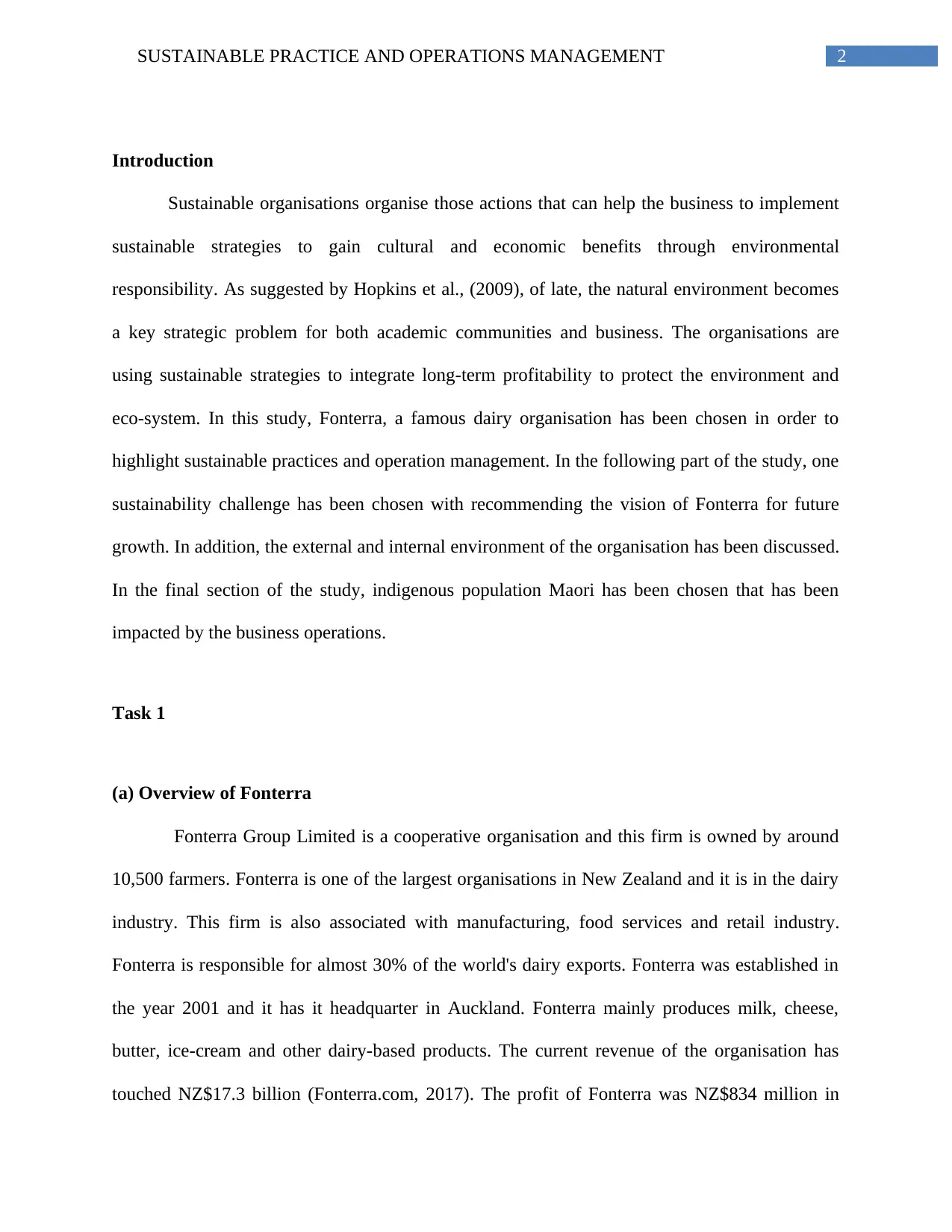
2SUSTAINABLE PRACTICE AND OPERATIONS MANAGEMENT
Introduction
Sustainable organisations organise those actions that can help the business to implement
sustainable strategies to gain cultural and economic benefits through environmental
responsibility. As suggested by Hopkins et al., (2009), of late, the natural environment becomes
a key strategic problem for both academic communities and business. The organisations are
using sustainable strategies to integrate long-term profitability to protect the environment and
eco-system. In this study, Fonterra, a famous dairy organisation has been chosen in order to
highlight sustainable practices and operation management. In the following part of the study, one
sustainability challenge has been chosen with recommending the vision of Fonterra for future
growth. In addition, the external and internal environment of the organisation has been discussed.
In the final section of the study, indigenous population Maori has been chosen that has been
impacted by the business operations.
Task 1
(a) Overview of Fonterra
Fonterra Group Limited is a cooperative organisation and this firm is owned by around
10,500 farmers. Fonterra is one of the largest organisations in New Zealand and it is in the dairy
industry. This firm is also associated with manufacturing, food services and retail industry.
Fonterra is responsible for almost 30% of the world's dairy exports. Fonterra was established in
the year 2001 and it has it headquarter in Auckland. Fonterra mainly produces milk, cheese,
butter, ice-cream and other dairy-based products. The current revenue of the organisation has
touched NZ$17.3 billion (Fonterra.com, 2017). The profit of Fonterra was NZ$834 million in
Introduction
Sustainable organisations organise those actions that can help the business to implement
sustainable strategies to gain cultural and economic benefits through environmental
responsibility. As suggested by Hopkins et al., (2009), of late, the natural environment becomes
a key strategic problem for both academic communities and business. The organisations are
using sustainable strategies to integrate long-term profitability to protect the environment and
eco-system. In this study, Fonterra, a famous dairy organisation has been chosen in order to
highlight sustainable practices and operation management. In the following part of the study, one
sustainability challenge has been chosen with recommending the vision of Fonterra for future
growth. In addition, the external and internal environment of the organisation has been discussed.
In the final section of the study, indigenous population Maori has been chosen that has been
impacted by the business operations.
Task 1
(a) Overview of Fonterra
Fonterra Group Limited is a cooperative organisation and this firm is owned by around
10,500 farmers. Fonterra is one of the largest organisations in New Zealand and it is in the dairy
industry. This firm is also associated with manufacturing, food services and retail industry.
Fonterra is responsible for almost 30% of the world's dairy exports. Fonterra was established in
the year 2001 and it has it headquarter in Auckland. Fonterra mainly produces milk, cheese,
butter, ice-cream and other dairy-based products. The current revenue of the organisation has
touched NZ$17.3 billion (Fonterra.com, 2017). The profit of Fonterra was NZ$834 million in
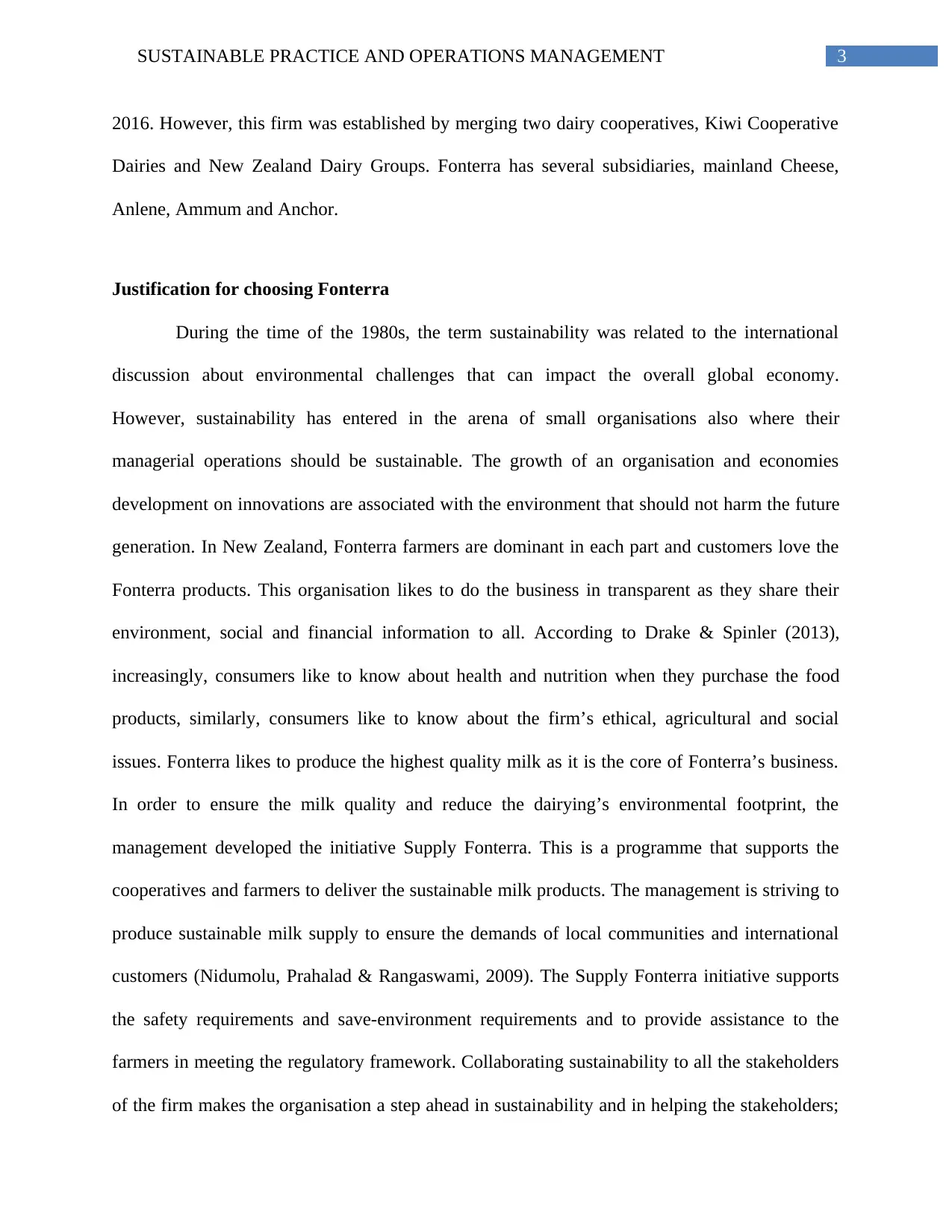
3SUSTAINABLE PRACTICE AND OPERATIONS MANAGEMENT
2016. However, this firm was established by merging two dairy cooperatives, Kiwi Cooperative
Dairies and New Zealand Dairy Groups. Fonterra has several subsidiaries, mainland Cheese,
Anlene, Ammum and Anchor.
Justification for choosing Fonterra
During the time of the 1980s, the term sustainability was related to the international
discussion about environmental challenges that can impact the overall global economy.
However, sustainability has entered in the arena of small organisations also where their
managerial operations should be sustainable. The growth of an organisation and economies
development on innovations are associated with the environment that should not harm the future
generation. In New Zealand, Fonterra farmers are dominant in each part and customers love the
Fonterra products. This organisation likes to do the business in transparent as they share their
environment, social and financial information to all. According to Drake & Spinler (2013),
increasingly, consumers like to know about health and nutrition when they purchase the food
products, similarly, consumers like to know about the firm’s ethical, agricultural and social
issues. Fonterra likes to produce the highest quality milk as it is the core of Fonterra’s business.
In order to ensure the milk quality and reduce the dairying’s environmental footprint, the
management developed the initiative Supply Fonterra. This is a programme that supports the
cooperatives and farmers to deliver the sustainable milk products. The management is striving to
produce sustainable milk supply to ensure the demands of local communities and international
customers (Nidumolu, Prahalad & Rangaswami, 2009). The Supply Fonterra initiative supports
the safety requirements and save-environment requirements and to provide assistance to the
farmers in meeting the regulatory framework. Collaborating sustainability to all the stakeholders
of the firm makes the organisation a step ahead in sustainability and in helping the stakeholders;
2016. However, this firm was established by merging two dairy cooperatives, Kiwi Cooperative
Dairies and New Zealand Dairy Groups. Fonterra has several subsidiaries, mainland Cheese,
Anlene, Ammum and Anchor.
Justification for choosing Fonterra
During the time of the 1980s, the term sustainability was related to the international
discussion about environmental challenges that can impact the overall global economy.
However, sustainability has entered in the arena of small organisations also where their
managerial operations should be sustainable. The growth of an organisation and economies
development on innovations are associated with the environment that should not harm the future
generation. In New Zealand, Fonterra farmers are dominant in each part and customers love the
Fonterra products. This organisation likes to do the business in transparent as they share their
environment, social and financial information to all. According to Drake & Spinler (2013),
increasingly, consumers like to know about health and nutrition when they purchase the food
products, similarly, consumers like to know about the firm’s ethical, agricultural and social
issues. Fonterra likes to produce the highest quality milk as it is the core of Fonterra’s business.
In order to ensure the milk quality and reduce the dairying’s environmental footprint, the
management developed the initiative Supply Fonterra. This is a programme that supports the
cooperatives and farmers to deliver the sustainable milk products. The management is striving to
produce sustainable milk supply to ensure the demands of local communities and international
customers (Nidumolu, Prahalad & Rangaswami, 2009). The Supply Fonterra initiative supports
the safety requirements and save-environment requirements and to provide assistance to the
farmers in meeting the regulatory framework. Collaborating sustainability to all the stakeholders
of the firm makes the organisation a step ahead in sustainability and in helping the stakeholders;
Secure Best Marks with AI Grader
Need help grading? Try our AI Grader for instant feedback on your assignments.
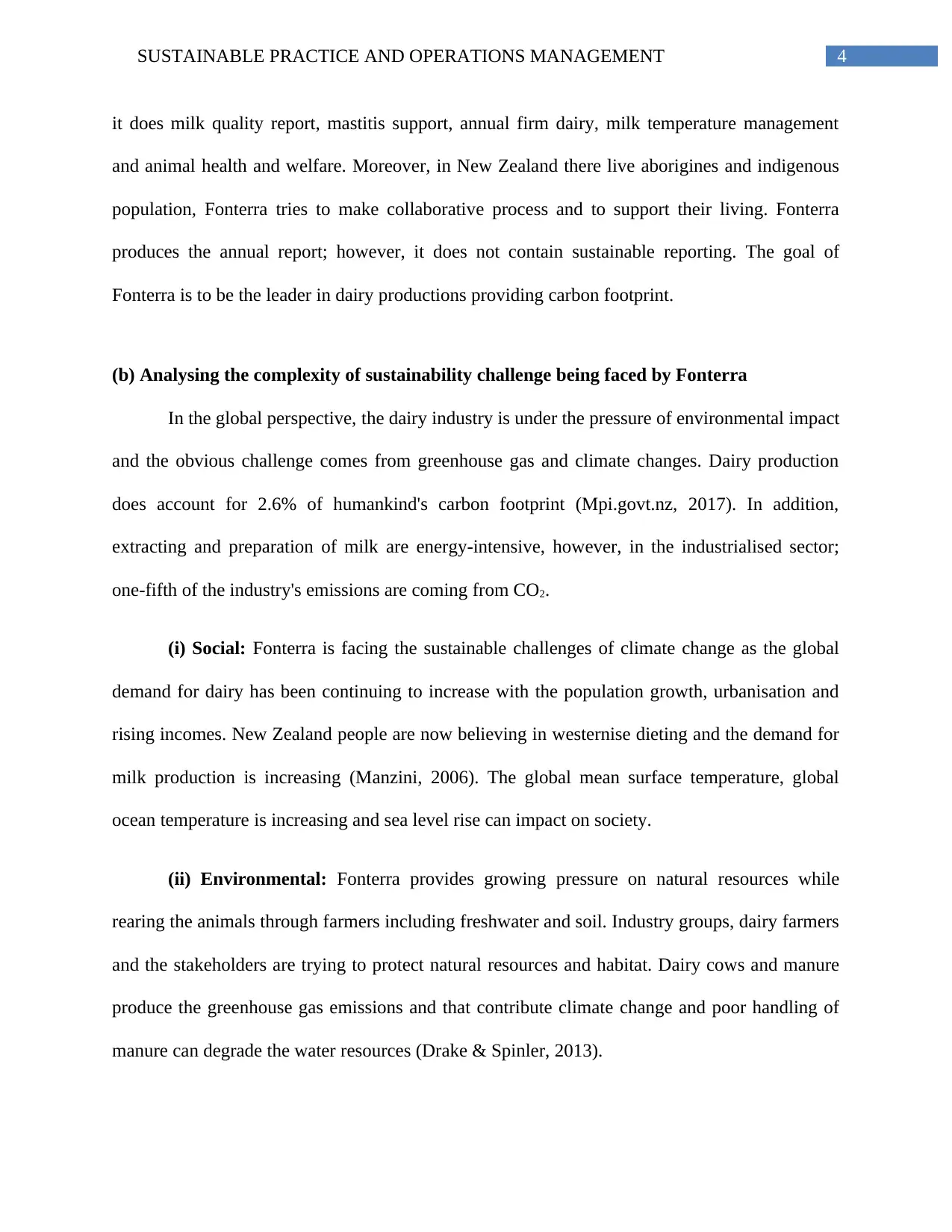
4SUSTAINABLE PRACTICE AND OPERATIONS MANAGEMENT
it does milk quality report, mastitis support, annual firm dairy, milk temperature management
and animal health and welfare. Moreover, in New Zealand there live aborigines and indigenous
population, Fonterra tries to make collaborative process and to support their living. Fonterra
produces the annual report; however, it does not contain sustainable reporting. The goal of
Fonterra is to be the leader in dairy productions providing carbon footprint.
(b) Analysing the complexity of sustainability challenge being faced by Fonterra
In the global perspective, the dairy industry is under the pressure of environmental impact
and the obvious challenge comes from greenhouse gas and climate changes. Dairy production
does account for 2.6% of humankind's carbon footprint (Mpi.govt.nz, 2017). In addition,
extracting and preparation of milk are energy-intensive, however, in the industrialised sector;
one-fifth of the industry's emissions are coming from CO2.
(i) Social: Fonterra is facing the sustainable challenges of climate change as the global
demand for dairy has been continuing to increase with the population growth, urbanisation and
rising incomes. New Zealand people are now believing in westernise dieting and the demand for
milk production is increasing (Manzini, 2006). The global mean surface temperature, global
ocean temperature is increasing and sea level rise can impact on society.
(ii) Environmental: Fonterra provides growing pressure on natural resources while
rearing the animals through farmers including freshwater and soil. Industry groups, dairy farmers
and the stakeholders are trying to protect natural resources and habitat. Dairy cows and manure
produce the greenhouse gas emissions and that contribute climate change and poor handling of
manure can degrade the water resources (Drake & Spinler, 2013).
it does milk quality report, mastitis support, annual firm dairy, milk temperature management
and animal health and welfare. Moreover, in New Zealand there live aborigines and indigenous
population, Fonterra tries to make collaborative process and to support their living. Fonterra
produces the annual report; however, it does not contain sustainable reporting. The goal of
Fonterra is to be the leader in dairy productions providing carbon footprint.
(b) Analysing the complexity of sustainability challenge being faced by Fonterra
In the global perspective, the dairy industry is under the pressure of environmental impact
and the obvious challenge comes from greenhouse gas and climate changes. Dairy production
does account for 2.6% of humankind's carbon footprint (Mpi.govt.nz, 2017). In addition,
extracting and preparation of milk are energy-intensive, however, in the industrialised sector;
one-fifth of the industry's emissions are coming from CO2.
(i) Social: Fonterra is facing the sustainable challenges of climate change as the global
demand for dairy has been continuing to increase with the population growth, urbanisation and
rising incomes. New Zealand people are now believing in westernise dieting and the demand for
milk production is increasing (Manzini, 2006). The global mean surface temperature, global
ocean temperature is increasing and sea level rise can impact on society.
(ii) Environmental: Fonterra provides growing pressure on natural resources while
rearing the animals through farmers including freshwater and soil. Industry groups, dairy farmers
and the stakeholders are trying to protect natural resources and habitat. Dairy cows and manure
produce the greenhouse gas emissions and that contribute climate change and poor handling of
manure can degrade the water resources (Drake & Spinler, 2013).
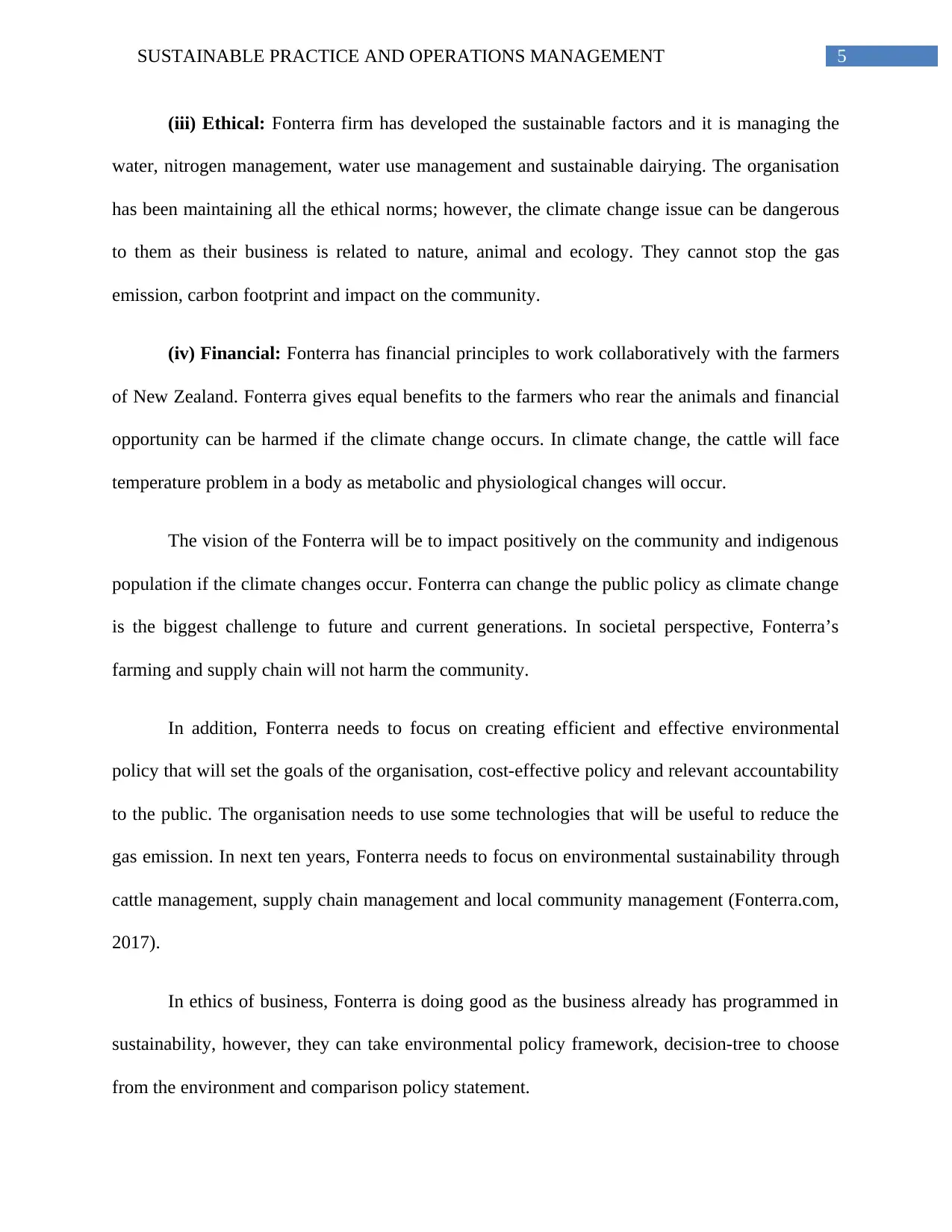
5SUSTAINABLE PRACTICE AND OPERATIONS MANAGEMENT
(iii) Ethical: Fonterra firm has developed the sustainable factors and it is managing the
water, nitrogen management, water use management and sustainable dairying. The organisation
has been maintaining all the ethical norms; however, the climate change issue can be dangerous
to them as their business is related to nature, animal and ecology. They cannot stop the gas
emission, carbon footprint and impact on the community.
(iv) Financial: Fonterra has financial principles to work collaboratively with the farmers
of New Zealand. Fonterra gives equal benefits to the farmers who rear the animals and financial
opportunity can be harmed if the climate change occurs. In climate change, the cattle will face
temperature problem in a body as metabolic and physiological changes will occur.
The vision of the Fonterra will be to impact positively on the community and indigenous
population if the climate changes occur. Fonterra can change the public policy as climate change
is the biggest challenge to future and current generations. In societal perspective, Fonterra’s
farming and supply chain will not harm the community.
In addition, Fonterra needs to focus on creating efficient and effective environmental
policy that will set the goals of the organisation, cost-effective policy and relevant accountability
to the public. The organisation needs to use some technologies that will be useful to reduce the
gas emission. In next ten years, Fonterra needs to focus on environmental sustainability through
cattle management, supply chain management and local community management (Fonterra.com,
2017).
In ethics of business, Fonterra is doing good as the business already has programmed in
sustainability, however, they can take environmental policy framework, decision-tree to choose
from the environment and comparison policy statement.
(iii) Ethical: Fonterra firm has developed the sustainable factors and it is managing the
water, nitrogen management, water use management and sustainable dairying. The organisation
has been maintaining all the ethical norms; however, the climate change issue can be dangerous
to them as their business is related to nature, animal and ecology. They cannot stop the gas
emission, carbon footprint and impact on the community.
(iv) Financial: Fonterra has financial principles to work collaboratively with the farmers
of New Zealand. Fonterra gives equal benefits to the farmers who rear the animals and financial
opportunity can be harmed if the climate change occurs. In climate change, the cattle will face
temperature problem in a body as metabolic and physiological changes will occur.
The vision of the Fonterra will be to impact positively on the community and indigenous
population if the climate changes occur. Fonterra can change the public policy as climate change
is the biggest challenge to future and current generations. In societal perspective, Fonterra’s
farming and supply chain will not harm the community.
In addition, Fonterra needs to focus on creating efficient and effective environmental
policy that will set the goals of the organisation, cost-effective policy and relevant accountability
to the public. The organisation needs to use some technologies that will be useful to reduce the
gas emission. In next ten years, Fonterra needs to focus on environmental sustainability through
cattle management, supply chain management and local community management (Fonterra.com,
2017).
In ethics of business, Fonterra is doing good as the business already has programmed in
sustainability, however, they can take environmental policy framework, decision-tree to choose
from the environment and comparison policy statement.
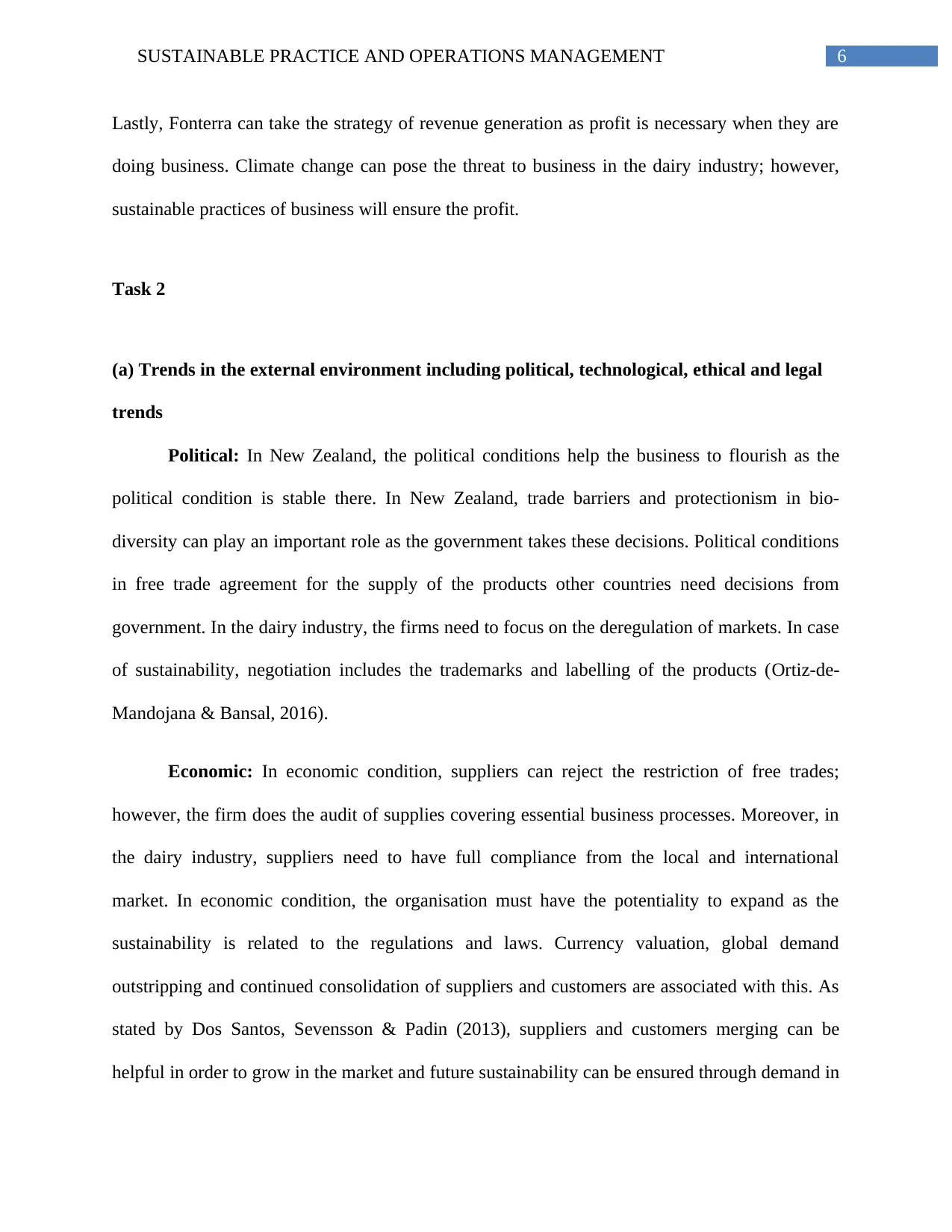
6SUSTAINABLE PRACTICE AND OPERATIONS MANAGEMENT
Lastly, Fonterra can take the strategy of revenue generation as profit is necessary when they are
doing business. Climate change can pose the threat to business in the dairy industry; however,
sustainable practices of business will ensure the profit.
Task 2
(a) Trends in the external environment including political, technological, ethical and legal
trends
Political: In New Zealand, the political conditions help the business to flourish as the
political condition is stable there. In New Zealand, trade barriers and protectionism in bio-
diversity can play an important role as the government takes these decisions. Political conditions
in free trade agreement for the supply of the products other countries need decisions from
government. In the dairy industry, the firms need to focus on the deregulation of markets. In case
of sustainability, negotiation includes the trademarks and labelling of the products (Ortiz‐de‐
Mandojana & Bansal, 2016).
Economic: In economic condition, suppliers can reject the restriction of free trades;
however, the firm does the audit of supplies covering essential business processes. Moreover, in
the dairy industry, suppliers need to have full compliance from the local and international
market. In economic condition, the organisation must have the potentiality to expand as the
sustainability is related to the regulations and laws. Currency valuation, global demand
outstripping and continued consolidation of suppliers and customers are associated with this. As
stated by Dos Santos, Sevensson & Padin (2013), suppliers and customers merging can be
helpful in order to grow in the market and future sustainability can be ensured through demand in
Lastly, Fonterra can take the strategy of revenue generation as profit is necessary when they are
doing business. Climate change can pose the threat to business in the dairy industry; however,
sustainable practices of business will ensure the profit.
Task 2
(a) Trends in the external environment including political, technological, ethical and legal
trends
Political: In New Zealand, the political conditions help the business to flourish as the
political condition is stable there. In New Zealand, trade barriers and protectionism in bio-
diversity can play an important role as the government takes these decisions. Political conditions
in free trade agreement for the supply of the products other countries need decisions from
government. In the dairy industry, the firms need to focus on the deregulation of markets. In case
of sustainability, negotiation includes the trademarks and labelling of the products (Ortiz‐de‐
Mandojana & Bansal, 2016).
Economic: In economic condition, suppliers can reject the restriction of free trades;
however, the firm does the audit of supplies covering essential business processes. Moreover, in
the dairy industry, suppliers need to have full compliance from the local and international
market. In economic condition, the organisation must have the potentiality to expand as the
sustainability is related to the regulations and laws. Currency valuation, global demand
outstripping and continued consolidation of suppliers and customers are associated with this. As
stated by Dos Santos, Sevensson & Padin (2013), suppliers and customers merging can be
helpful in order to grow in the market and future sustainability can be ensured through demand in
Paraphrase This Document
Need a fresh take? Get an instant paraphrase of this document with our AI Paraphraser
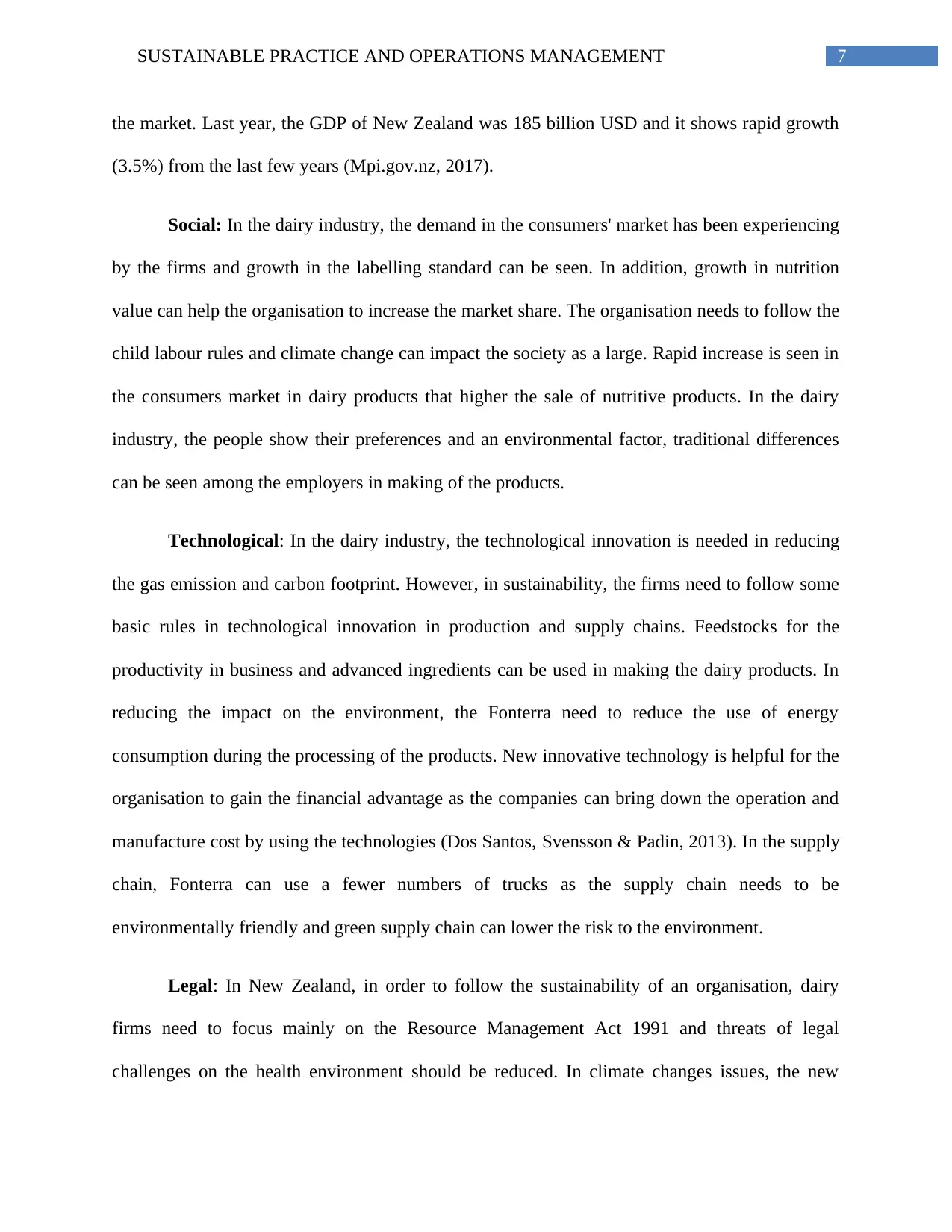
7SUSTAINABLE PRACTICE AND OPERATIONS MANAGEMENT
the market. Last year, the GDP of New Zealand was 185 billion USD and it shows rapid growth
(3.5%) from the last few years (Mpi.gov.nz, 2017).
Social: In the dairy industry, the demand in the consumers' market has been experiencing
by the firms and growth in the labelling standard can be seen. In addition, growth in nutrition
value can help the organisation to increase the market share. The organisation needs to follow the
child labour rules and climate change can impact the society as a large. Rapid increase is seen in
the consumers market in dairy products that higher the sale of nutritive products. In the dairy
industry, the people show their preferences and an environmental factor, traditional differences
can be seen among the employers in making of the products.
Technological: In the dairy industry, the technological innovation is needed in reducing
the gas emission and carbon footprint. However, in sustainability, the firms need to follow some
basic rules in technological innovation in production and supply chains. Feedstocks for the
productivity in business and advanced ingredients can be used in making the dairy products. In
reducing the impact on the environment, the Fonterra need to reduce the use of energy
consumption during the processing of the products. New innovative technology is helpful for the
organisation to gain the financial advantage as the companies can bring down the operation and
manufacture cost by using the technologies (Dos Santos, Svensson & Padin, 2013). In the supply
chain, Fonterra can use a fewer numbers of trucks as the supply chain needs to be
environmentally friendly and green supply chain can lower the risk to the environment.
Legal: In New Zealand, in order to follow the sustainability of an organisation, dairy
firms need to focus mainly on the Resource Management Act 1991 and threats of legal
challenges on the health environment should be reduced. In climate changes issues, the new
the market. Last year, the GDP of New Zealand was 185 billion USD and it shows rapid growth
(3.5%) from the last few years (Mpi.gov.nz, 2017).
Social: In the dairy industry, the demand in the consumers' market has been experiencing
by the firms and growth in the labelling standard can be seen. In addition, growth in nutrition
value can help the organisation to increase the market share. The organisation needs to follow the
child labour rules and climate change can impact the society as a large. Rapid increase is seen in
the consumers market in dairy products that higher the sale of nutritive products. In the dairy
industry, the people show their preferences and an environmental factor, traditional differences
can be seen among the employers in making of the products.
Technological: In the dairy industry, the technological innovation is needed in reducing
the gas emission and carbon footprint. However, in sustainability, the firms need to follow some
basic rules in technological innovation in production and supply chains. Feedstocks for the
productivity in business and advanced ingredients can be used in making the dairy products. In
reducing the impact on the environment, the Fonterra need to reduce the use of energy
consumption during the processing of the products. New innovative technology is helpful for the
organisation to gain the financial advantage as the companies can bring down the operation and
manufacture cost by using the technologies (Dos Santos, Svensson & Padin, 2013). In the supply
chain, Fonterra can use a fewer numbers of trucks as the supply chain needs to be
environmentally friendly and green supply chain can lower the risk to the environment.
Legal: In New Zealand, in order to follow the sustainability of an organisation, dairy
firms need to focus mainly on the Resource Management Act 1991 and threats of legal
challenges on the health environment should be reduced. In climate changes issues, the new

8SUSTAINABLE PRACTICE AND OPERATIONS MANAGEMENT
trend of protecting the environment, the dairy firms can launch new environmental policies.
Anti-competition commissions in New Zealand are now allowing the increase of large mergers.
Environmental: Recent trend in the sustainability of an organisation is related to the
climate change and environmental protection. Unpredictable climate, seasonal issues and bio-
diversity are some of the environmental issues. In dairy farming, Fonterra tries to focus on
environmental standards set by the organisation. In addition, dairy companies create a lot of
waste and in future, the firm will make safe handling, transportation and storing of the waste
(Padin et al., 2016). In the dairy industry, the companies must use the renewable energy in the
production and manufacturing process or in official works in this regard, reducing conventional
energy usage can help the environment to stay fresh and unpolluted.
(b) Strengths and weaknesses in responding to the opportunities and threats that stem from
the trends
The external environment of organisation Fonterra suggests that dairy industry is
expanding its market and sustainability plays an important role for an organisation. Fonterra
follows the sustainable practices within the workplace and operational management. The
sustainable practices raise the trend of less environmental influence by the firm. In the dairy
industry, the impact of climate change is varied and the organisation needs to manage the overall
protection of organisational management. The Fonterra has global trade and it uses exclusive
ingredients. In the market, Fonterra has a brand image and Fonterra food services has a customer
base.
Strengths:
trend of protecting the environment, the dairy firms can launch new environmental policies.
Anti-competition commissions in New Zealand are now allowing the increase of large mergers.
Environmental: Recent trend in the sustainability of an organisation is related to the
climate change and environmental protection. Unpredictable climate, seasonal issues and bio-
diversity are some of the environmental issues. In dairy farming, Fonterra tries to focus on
environmental standards set by the organisation. In addition, dairy companies create a lot of
waste and in future, the firm will make safe handling, transportation and storing of the waste
(Padin et al., 2016). In the dairy industry, the companies must use the renewable energy in the
production and manufacturing process or in official works in this regard, reducing conventional
energy usage can help the environment to stay fresh and unpolluted.
(b) Strengths and weaknesses in responding to the opportunities and threats that stem from
the trends
The external environment of organisation Fonterra suggests that dairy industry is
expanding its market and sustainability plays an important role for an organisation. Fonterra
follows the sustainable practices within the workplace and operational management. The
sustainable practices raise the trend of less environmental influence by the firm. In the dairy
industry, the impact of climate change is varied and the organisation needs to manage the overall
protection of organisational management. The Fonterra has global trade and it uses exclusive
ingredients. In the market, Fonterra has a brand image and Fonterra food services has a customer
base.
Strengths:
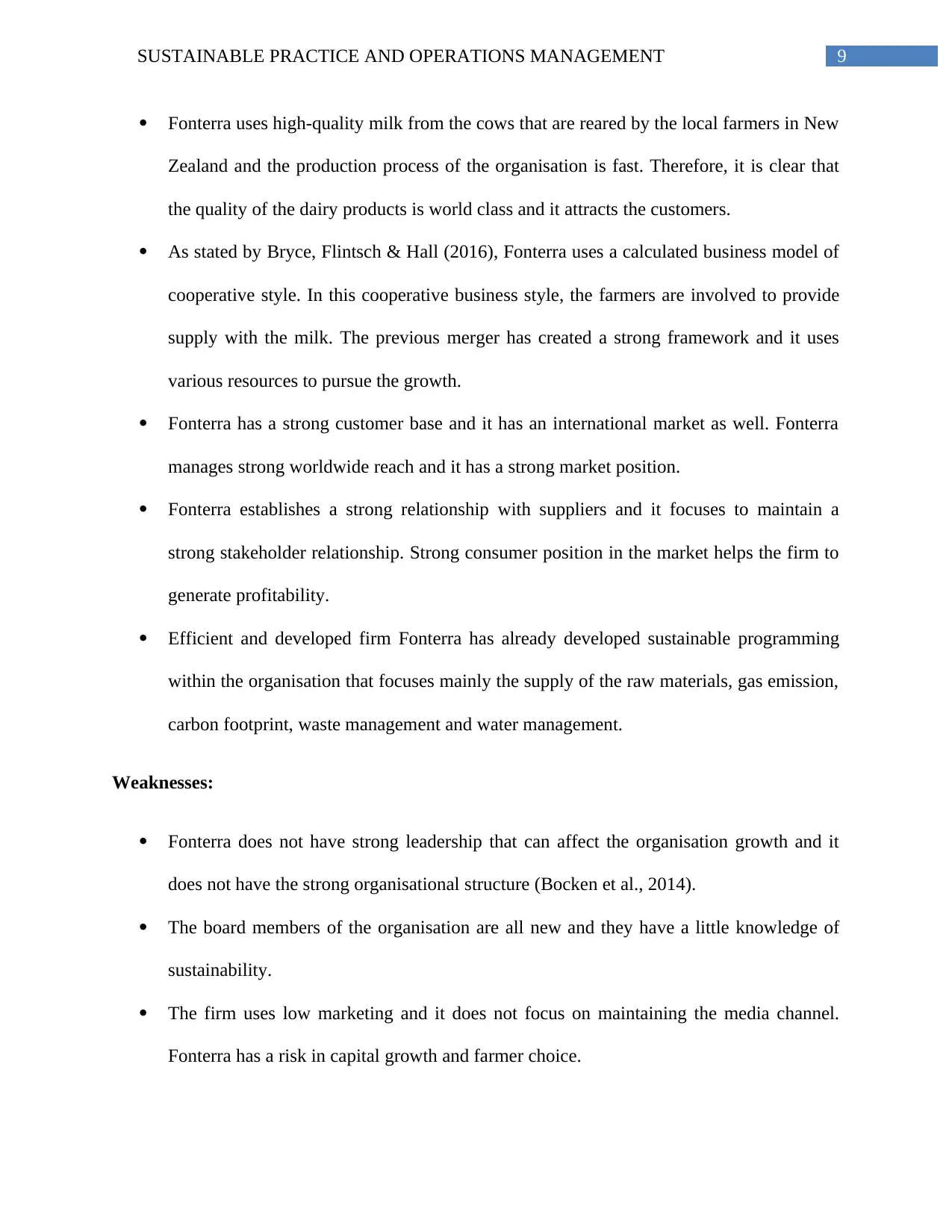
9SUSTAINABLE PRACTICE AND OPERATIONS MANAGEMENT
Fonterra uses high-quality milk from the cows that are reared by the local farmers in New
Zealand and the production process of the organisation is fast. Therefore, it is clear that
the quality of the dairy products is world class and it attracts the customers.
As stated by Bryce, Flintsch & Hall (2016), Fonterra uses a calculated business model of
cooperative style. In this cooperative business style, the farmers are involved to provide
supply with the milk. The previous merger has created a strong framework and it uses
various resources to pursue the growth.
Fonterra has a strong customer base and it has an international market as well. Fonterra
manages strong worldwide reach and it has a strong market position.
Fonterra establishes a strong relationship with suppliers and it focuses to maintain a
strong stakeholder relationship. Strong consumer position in the market helps the firm to
generate profitability.
Efficient and developed firm Fonterra has already developed sustainable programming
within the organisation that focuses mainly the supply of the raw materials, gas emission,
carbon footprint, waste management and water management.
Weaknesses:
Fonterra does not have strong leadership that can affect the organisation growth and it
does not have the strong organisational structure (Bocken et al., 2014).
The board members of the organisation are all new and they have a little knowledge of
sustainability.
The firm uses low marketing and it does not focus on maintaining the media channel.
Fonterra has a risk in capital growth and farmer choice.
Fonterra uses high-quality milk from the cows that are reared by the local farmers in New
Zealand and the production process of the organisation is fast. Therefore, it is clear that
the quality of the dairy products is world class and it attracts the customers.
As stated by Bryce, Flintsch & Hall (2016), Fonterra uses a calculated business model of
cooperative style. In this cooperative business style, the farmers are involved to provide
supply with the milk. The previous merger has created a strong framework and it uses
various resources to pursue the growth.
Fonterra has a strong customer base and it has an international market as well. Fonterra
manages strong worldwide reach and it has a strong market position.
Fonterra establishes a strong relationship with suppliers and it focuses to maintain a
strong stakeholder relationship. Strong consumer position in the market helps the firm to
generate profitability.
Efficient and developed firm Fonterra has already developed sustainable programming
within the organisation that focuses mainly the supply of the raw materials, gas emission,
carbon footprint, waste management and water management.
Weaknesses:
Fonterra does not have strong leadership that can affect the organisation growth and it
does not have the strong organisational structure (Bocken et al., 2014).
The board members of the organisation are all new and they have a little knowledge of
sustainability.
The firm uses low marketing and it does not focus on maintaining the media channel.
Fonterra has a risk in capital growth and farmer choice.
Secure Best Marks with AI Grader
Need help grading? Try our AI Grader for instant feedback on your assignments.
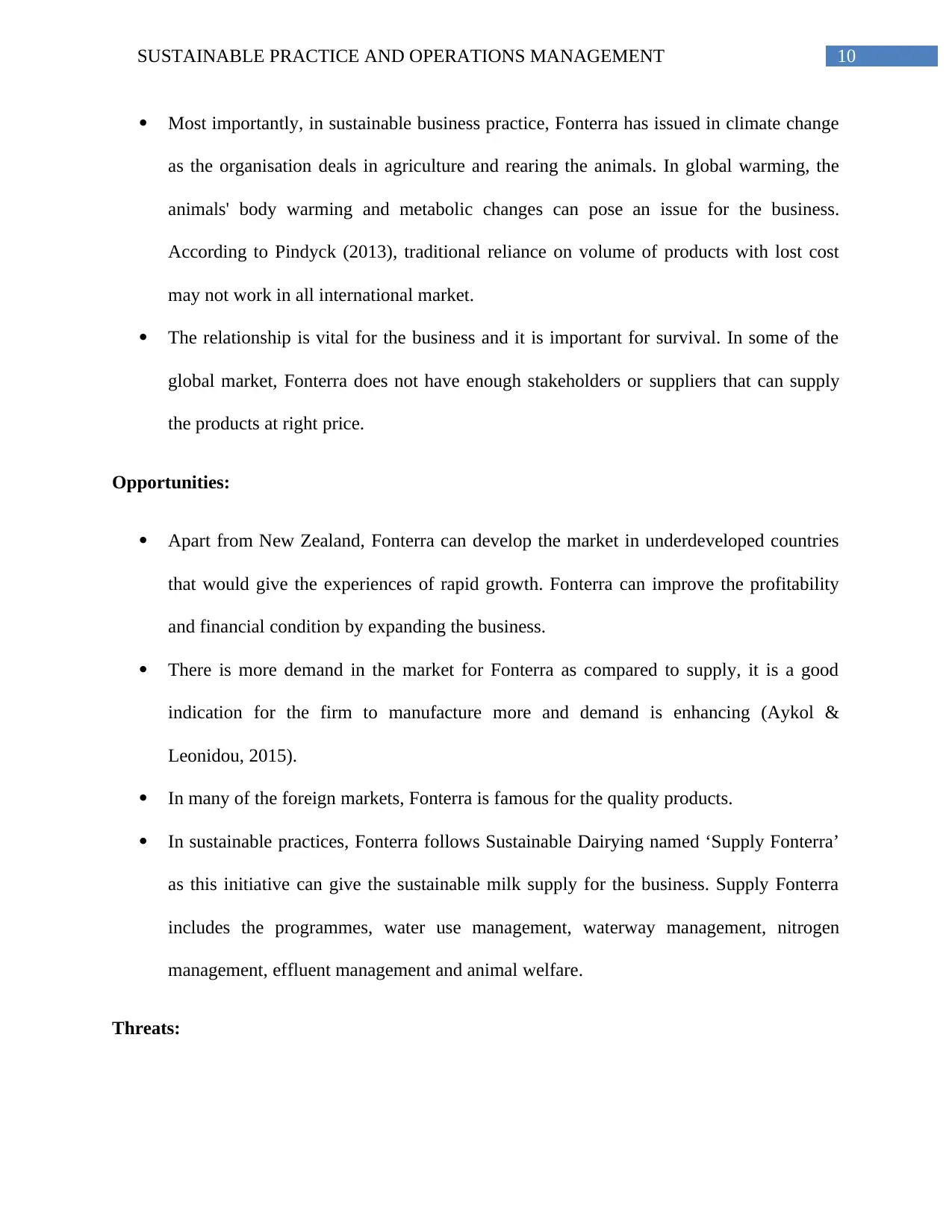
10SUSTAINABLE PRACTICE AND OPERATIONS MANAGEMENT
Most importantly, in sustainable business practice, Fonterra has issued in climate change
as the organisation deals in agriculture and rearing the animals. In global warming, the
animals' body warming and metabolic changes can pose an issue for the business.
According to Pindyck (2013), traditional reliance on volume of products with lost cost
may not work in all international market.
The relationship is vital for the business and it is important for survival. In some of the
global market, Fonterra does not have enough stakeholders or suppliers that can supply
the products at right price.
Opportunities:
Apart from New Zealand, Fonterra can develop the market in underdeveloped countries
that would give the experiences of rapid growth. Fonterra can improve the profitability
and financial condition by expanding the business.
There is more demand in the market for Fonterra as compared to supply, it is a good
indication for the firm to manufacture more and demand is enhancing (Aykol &
Leonidou, 2015).
In many of the foreign markets, Fonterra is famous for the quality products.
In sustainable practices, Fonterra follows Sustainable Dairying named ‘Supply Fonterra’
as this initiative can give the sustainable milk supply for the business. Supply Fonterra
includes the programmes, water use management, waterway management, nitrogen
management, effluent management and animal welfare.
Threats:
Most importantly, in sustainable business practice, Fonterra has issued in climate change
as the organisation deals in agriculture and rearing the animals. In global warming, the
animals' body warming and metabolic changes can pose an issue for the business.
According to Pindyck (2013), traditional reliance on volume of products with lost cost
may not work in all international market.
The relationship is vital for the business and it is important for survival. In some of the
global market, Fonterra does not have enough stakeholders or suppliers that can supply
the products at right price.
Opportunities:
Apart from New Zealand, Fonterra can develop the market in underdeveloped countries
that would give the experiences of rapid growth. Fonterra can improve the profitability
and financial condition by expanding the business.
There is more demand in the market for Fonterra as compared to supply, it is a good
indication for the firm to manufacture more and demand is enhancing (Aykol &
Leonidou, 2015).
In many of the foreign markets, Fonterra is famous for the quality products.
In sustainable practices, Fonterra follows Sustainable Dairying named ‘Supply Fonterra’
as this initiative can give the sustainable milk supply for the business. Supply Fonterra
includes the programmes, water use management, waterway management, nitrogen
management, effluent management and animal welfare.
Threats:
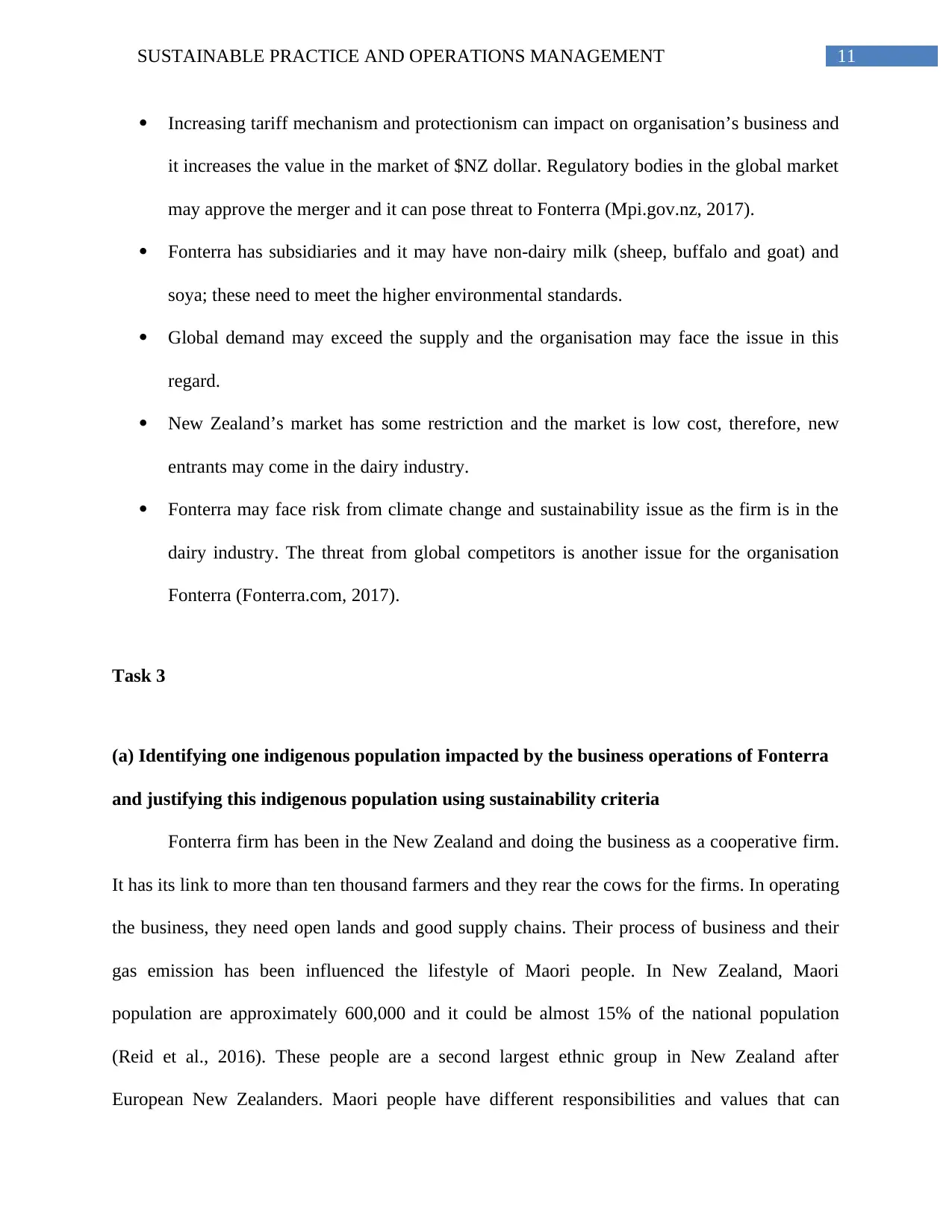
11SUSTAINABLE PRACTICE AND OPERATIONS MANAGEMENT
Increasing tariff mechanism and protectionism can impact on organisation’s business and
it increases the value in the market of $NZ dollar. Regulatory bodies in the global market
may approve the merger and it can pose threat to Fonterra (Mpi.gov.nz, 2017).
Fonterra has subsidiaries and it may have non-dairy milk (sheep, buffalo and goat) and
soya; these need to meet the higher environmental standards.
Global demand may exceed the supply and the organisation may face the issue in this
regard.
New Zealand’s market has some restriction and the market is low cost, therefore, new
entrants may come in the dairy industry.
Fonterra may face risk from climate change and sustainability issue as the firm is in the
dairy industry. The threat from global competitors is another issue for the organisation
Fonterra (Fonterra.com, 2017).
Task 3
(a) Identifying one indigenous population impacted by the business operations of Fonterra
and justifying this indigenous population using sustainability criteria
Fonterra firm has been in the New Zealand and doing the business as a cooperative firm.
It has its link to more than ten thousand farmers and they rear the cows for the firms. In operating
the business, they need open lands and good supply chains. Their process of business and their
gas emission has been influenced the lifestyle of Maori people. In New Zealand, Maori
population are approximately 600,000 and it could be almost 15% of the national population
(Reid et al., 2016). These people are a second largest ethnic group in New Zealand after
European New Zealanders. Maori people have different responsibilities and values that can
Increasing tariff mechanism and protectionism can impact on organisation’s business and
it increases the value in the market of $NZ dollar. Regulatory bodies in the global market
may approve the merger and it can pose threat to Fonterra (Mpi.gov.nz, 2017).
Fonterra has subsidiaries and it may have non-dairy milk (sheep, buffalo and goat) and
soya; these need to meet the higher environmental standards.
Global demand may exceed the supply and the organisation may face the issue in this
regard.
New Zealand’s market has some restriction and the market is low cost, therefore, new
entrants may come in the dairy industry.
Fonterra may face risk from climate change and sustainability issue as the firm is in the
dairy industry. The threat from global competitors is another issue for the organisation
Fonterra (Fonterra.com, 2017).
Task 3
(a) Identifying one indigenous population impacted by the business operations of Fonterra
and justifying this indigenous population using sustainability criteria
Fonterra firm has been in the New Zealand and doing the business as a cooperative firm.
It has its link to more than ten thousand farmers and they rear the cows for the firms. In operating
the business, they need open lands and good supply chains. Their process of business and their
gas emission has been influenced the lifestyle of Maori people. In New Zealand, Maori
population are approximately 600,000 and it could be almost 15% of the national population
(Reid et al., 2016). These people are a second largest ethnic group in New Zealand after
European New Zealanders. Maori people have different responsibilities and values that can
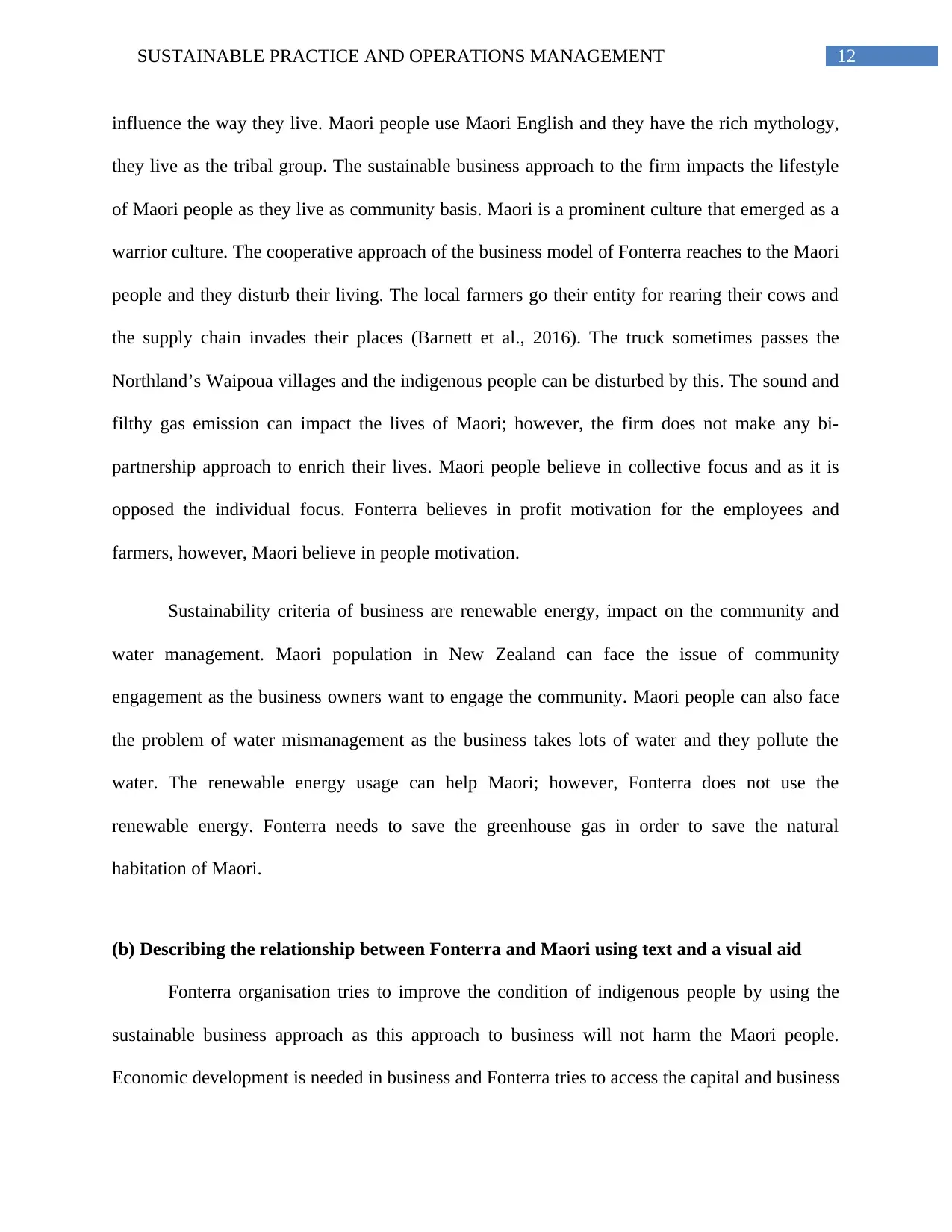
12SUSTAINABLE PRACTICE AND OPERATIONS MANAGEMENT
influence the way they live. Maori people use Maori English and they have the rich mythology,
they live as the tribal group. The sustainable business approach to the firm impacts the lifestyle
of Maori people as they live as community basis. Maori is a prominent culture that emerged as a
warrior culture. The cooperative approach of the business model of Fonterra reaches to the Maori
people and they disturb their living. The local farmers go their entity for rearing their cows and
the supply chain invades their places (Barnett et al., 2016). The truck sometimes passes the
Northland’s Waipoua villages and the indigenous people can be disturbed by this. The sound and
filthy gas emission can impact the lives of Maori; however, the firm does not make any bi-
partnership approach to enrich their lives. Maori people believe in collective focus and as it is
opposed the individual focus. Fonterra believes in profit motivation for the employees and
farmers, however, Maori believe in people motivation.
Sustainability criteria of business are renewable energy, impact on the community and
water management. Maori population in New Zealand can face the issue of community
engagement as the business owners want to engage the community. Maori people can also face
the problem of water mismanagement as the business takes lots of water and they pollute the
water. The renewable energy usage can help Maori; however, Fonterra does not use the
renewable energy. Fonterra needs to save the greenhouse gas in order to save the natural
habitation of Maori.
(b) Describing the relationship between Fonterra and Maori using text and a visual aid
Fonterra organisation tries to improve the condition of indigenous people by using the
sustainable business approach as this approach to business will not harm the Maori people.
Economic development is needed in business and Fonterra tries to access the capital and business
influence the way they live. Maori people use Maori English and they have the rich mythology,
they live as the tribal group. The sustainable business approach to the firm impacts the lifestyle
of Maori people as they live as community basis. Maori is a prominent culture that emerged as a
warrior culture. The cooperative approach of the business model of Fonterra reaches to the Maori
people and they disturb their living. The local farmers go their entity for rearing their cows and
the supply chain invades their places (Barnett et al., 2016). The truck sometimes passes the
Northland’s Waipoua villages and the indigenous people can be disturbed by this. The sound and
filthy gas emission can impact the lives of Maori; however, the firm does not make any bi-
partnership approach to enrich their lives. Maori people believe in collective focus and as it is
opposed the individual focus. Fonterra believes in profit motivation for the employees and
farmers, however, Maori believe in people motivation.
Sustainability criteria of business are renewable energy, impact on the community and
water management. Maori population in New Zealand can face the issue of community
engagement as the business owners want to engage the community. Maori people can also face
the problem of water mismanagement as the business takes lots of water and they pollute the
water. The renewable energy usage can help Maori; however, Fonterra does not use the
renewable energy. Fonterra needs to save the greenhouse gas in order to save the natural
habitation of Maori.
(b) Describing the relationship between Fonterra and Maori using text and a visual aid
Fonterra organisation tries to improve the condition of indigenous people by using the
sustainable business approach as this approach to business will not harm the Maori people.
Economic development is needed in business and Fonterra tries to access the capital and business
Paraphrase This Document
Need a fresh take? Get an instant paraphrase of this document with our AI Paraphraser
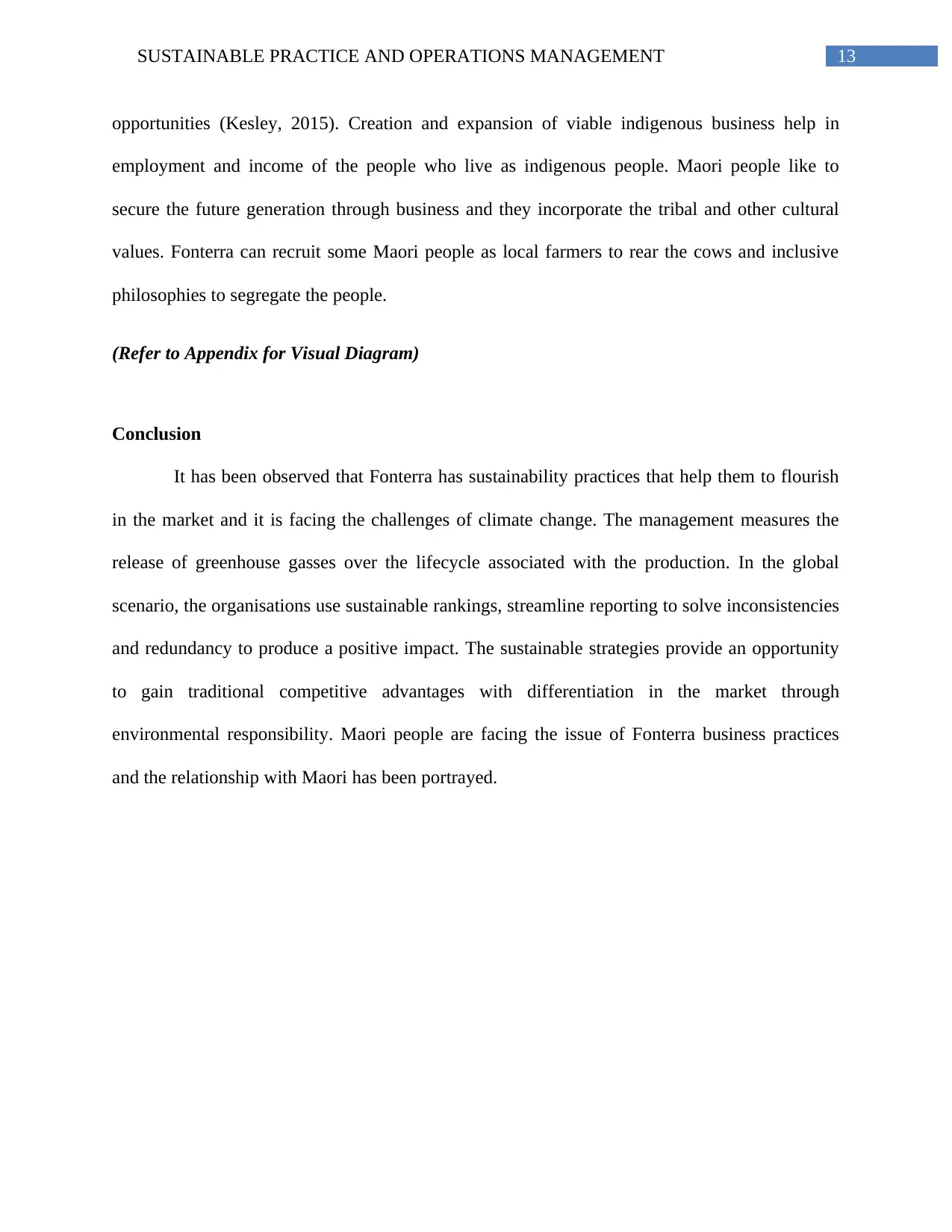
13SUSTAINABLE PRACTICE AND OPERATIONS MANAGEMENT
opportunities (Kesley, 2015). Creation and expansion of viable indigenous business help in
employment and income of the people who live as indigenous people. Maori people like to
secure the future generation through business and they incorporate the tribal and other cultural
values. Fonterra can recruit some Maori people as local farmers to rear the cows and inclusive
philosophies to segregate the people.
(Refer to Appendix for Visual Diagram)
Conclusion
It has been observed that Fonterra has sustainability practices that help them to flourish
in the market and it is facing the challenges of climate change. The management measures the
release of greenhouse gasses over the lifecycle associated with the production. In the global
scenario, the organisations use sustainable rankings, streamline reporting to solve inconsistencies
and redundancy to produce a positive impact. The sustainable strategies provide an opportunity
to gain traditional competitive advantages with differentiation in the market through
environmental responsibility. Maori people are facing the issue of Fonterra business practices
and the relationship with Maori has been portrayed.
opportunities (Kesley, 2015). Creation and expansion of viable indigenous business help in
employment and income of the people who live as indigenous people. Maori people like to
secure the future generation through business and they incorporate the tribal and other cultural
values. Fonterra can recruit some Maori people as local farmers to rear the cows and inclusive
philosophies to segregate the people.
(Refer to Appendix for Visual Diagram)
Conclusion
It has been observed that Fonterra has sustainability practices that help them to flourish
in the market and it is facing the challenges of climate change. The management measures the
release of greenhouse gasses over the lifecycle associated with the production. In the global
scenario, the organisations use sustainable rankings, streamline reporting to solve inconsistencies
and redundancy to produce a positive impact. The sustainable strategies provide an opportunity
to gain traditional competitive advantages with differentiation in the market through
environmental responsibility. Maori people are facing the issue of Fonterra business practices
and the relationship with Maori has been portrayed.
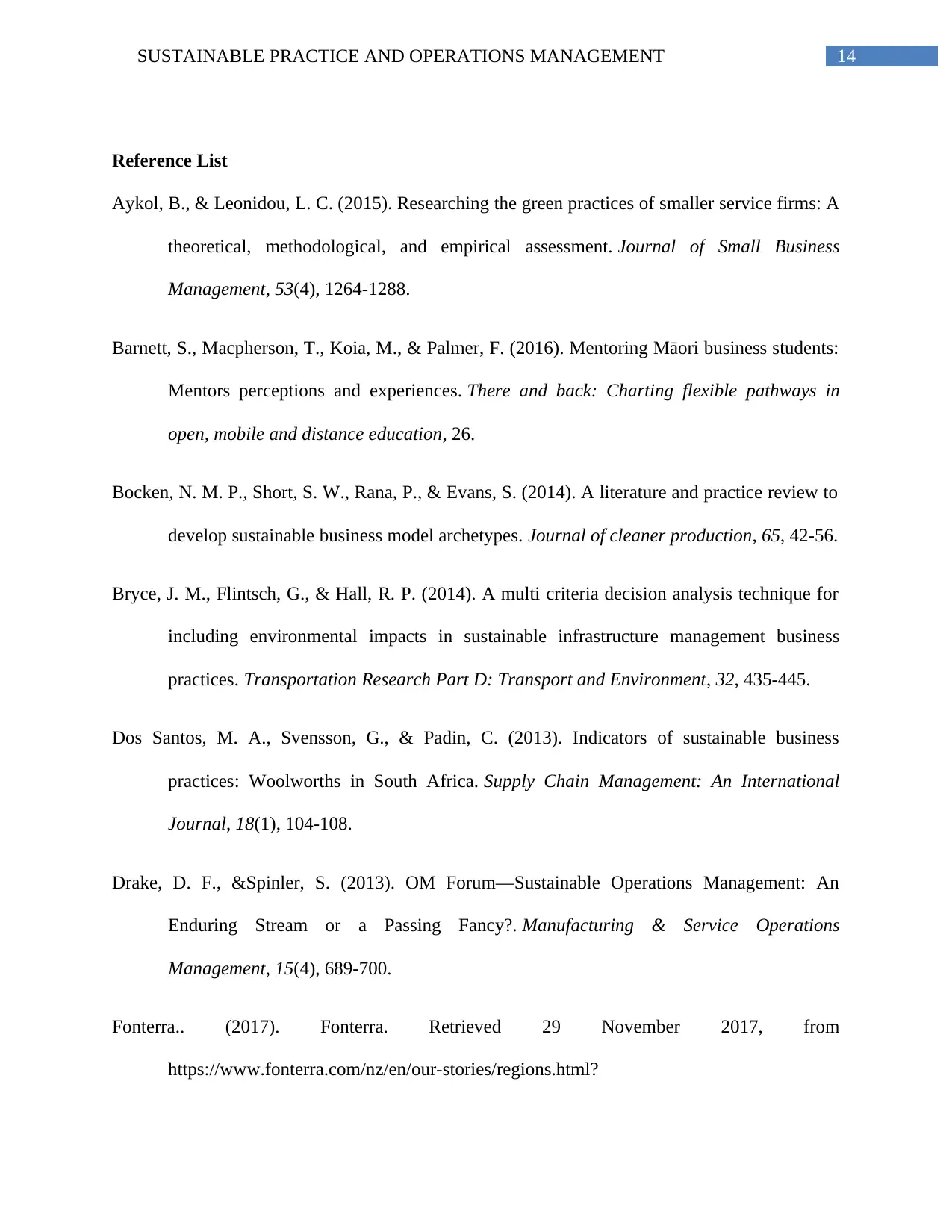
14SUSTAINABLE PRACTICE AND OPERATIONS MANAGEMENT
Reference List
Aykol, B., & Leonidou, L. C. (2015). Researching the green practices of smaller service firms: A
theoretical, methodological, and empirical assessment. Journal of Small Business
Management, 53(4), 1264-1288.
Barnett, S., Macpherson, T., Koia, M., & Palmer, F. (2016). Mentoring Māori business students:
Mentors perceptions and experiences. There and back: Charting flexible pathways in
open, mobile and distance education, 26.
Bocken, N. M. P., Short, S. W., Rana, P., & Evans, S. (2014). A literature and practice review to
develop sustainable business model archetypes. Journal of cleaner production, 65, 42-56.
Bryce, J. M., Flintsch, G., & Hall, R. P. (2014). A multi criteria decision analysis technique for
including environmental impacts in sustainable infrastructure management business
practices. Transportation Research Part D: Transport and Environment, 32, 435-445.
Dos Santos, M. A., Svensson, G., & Padin, C. (2013). Indicators of sustainable business
practices: Woolworths in South Africa. Supply Chain Management: An International
Journal, 18(1), 104-108.
Drake, D. F., &Spinler, S. (2013). OM Forum—Sustainable Operations Management: An
Enduring Stream or a Passing Fancy?. Manufacturing & Service Operations
Management, 15(4), 689-700.
Fonterra.. (2017). Fonterra. Retrieved 29 November 2017, from
https://www.fonterra.com/nz/en/our-stories/regions.html?
Reference List
Aykol, B., & Leonidou, L. C. (2015). Researching the green practices of smaller service firms: A
theoretical, methodological, and empirical assessment. Journal of Small Business
Management, 53(4), 1264-1288.
Barnett, S., Macpherson, T., Koia, M., & Palmer, F. (2016). Mentoring Māori business students:
Mentors perceptions and experiences. There and back: Charting flexible pathways in
open, mobile and distance education, 26.
Bocken, N. M. P., Short, S. W., Rana, P., & Evans, S. (2014). A literature and practice review to
develop sustainable business model archetypes. Journal of cleaner production, 65, 42-56.
Bryce, J. M., Flintsch, G., & Hall, R. P. (2014). A multi criteria decision analysis technique for
including environmental impacts in sustainable infrastructure management business
practices. Transportation Research Part D: Transport and Environment, 32, 435-445.
Dos Santos, M. A., Svensson, G., & Padin, C. (2013). Indicators of sustainable business
practices: Woolworths in South Africa. Supply Chain Management: An International
Journal, 18(1), 104-108.
Drake, D. F., &Spinler, S. (2013). OM Forum—Sustainable Operations Management: An
Enduring Stream or a Passing Fancy?. Manufacturing & Service Operations
Management, 15(4), 689-700.
Fonterra.. (2017). Fonterra. Retrieved 29 November 2017, from
https://www.fonterra.com/nz/en/our-stories/regions.html?
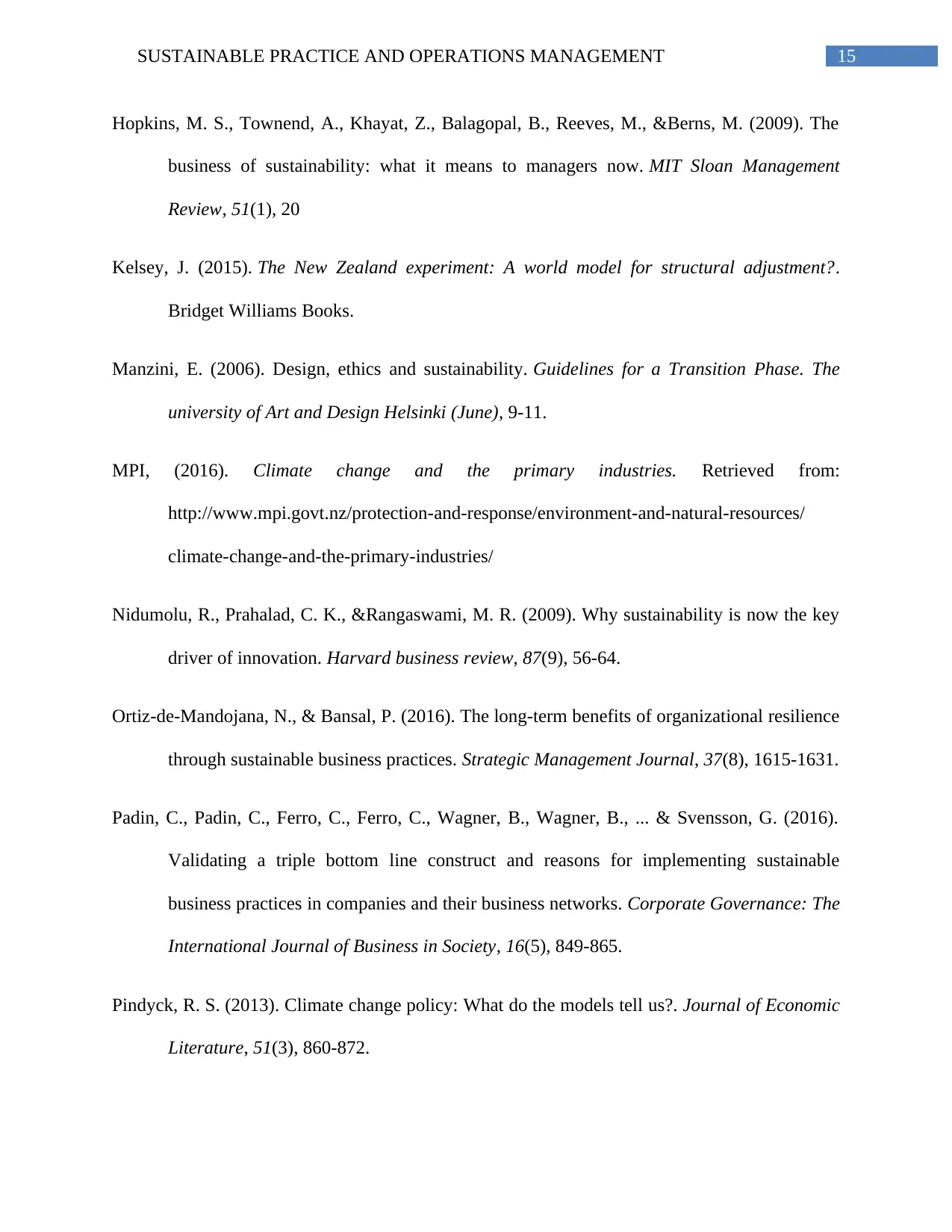
15SUSTAINABLE PRACTICE AND OPERATIONS MANAGEMENT
Hopkins, M. S., Townend, A., Khayat, Z., Balagopal, B., Reeves, M., &Berns, M. (2009). The
business of sustainability: what it means to managers now. MIT Sloan Management
Review, 51(1), 20
Kelsey, J. (2015). The New Zealand experiment: A world model for structural adjustment?.
Bridget Williams Books.
Manzini, E. (2006). Design, ethics and sustainability. Guidelines for a Transition Phase. The
university of Art and Design Helsinki (June), 9-11.
MPI, (2016). Climate change and the primary industries. Retrieved from:
http://www.mpi.govt.nz/protection-and-response/environment-and-natural-resources/
climate-change-and-the-primary-industries/
Nidumolu, R., Prahalad, C. K., &Rangaswami, M. R. (2009). Why sustainability is now the key
driver of innovation. Harvard business review, 87(9), 56-64.
Ortiz‐de‐Mandojana, N., & Bansal, P. (2016). The long‐term benefits of organizational resilience
through sustainable business practices. Strategic Management Journal, 37(8), 1615-1631.
Padin, C., Padin, C., Ferro, C., Ferro, C., Wagner, B., Wagner, B., ... & Svensson, G. (2016).
Validating a triple bottom line construct and reasons for implementing sustainable
business practices in companies and their business networks. Corporate Governance: The
International Journal of Business in Society, 16(5), 849-865.
Pindyck, R. S. (2013). Climate change policy: What do the models tell us?. Journal of Economic
Literature, 51(3), 860-872.
Hopkins, M. S., Townend, A., Khayat, Z., Balagopal, B., Reeves, M., &Berns, M. (2009). The
business of sustainability: what it means to managers now. MIT Sloan Management
Review, 51(1), 20
Kelsey, J. (2015). The New Zealand experiment: A world model for structural adjustment?.
Bridget Williams Books.
Manzini, E. (2006). Design, ethics and sustainability. Guidelines for a Transition Phase. The
university of Art and Design Helsinki (June), 9-11.
MPI, (2016). Climate change and the primary industries. Retrieved from:
http://www.mpi.govt.nz/protection-and-response/environment-and-natural-resources/
climate-change-and-the-primary-industries/
Nidumolu, R., Prahalad, C. K., &Rangaswami, M. R. (2009). Why sustainability is now the key
driver of innovation. Harvard business review, 87(9), 56-64.
Ortiz‐de‐Mandojana, N., & Bansal, P. (2016). The long‐term benefits of organizational resilience
through sustainable business practices. Strategic Management Journal, 37(8), 1615-1631.
Padin, C., Padin, C., Ferro, C., Ferro, C., Wagner, B., Wagner, B., ... & Svensson, G. (2016).
Validating a triple bottom line construct and reasons for implementing sustainable
business practices in companies and their business networks. Corporate Governance: The
International Journal of Business in Society, 16(5), 849-865.
Pindyck, R. S. (2013). Climate change policy: What do the models tell us?. Journal of Economic
Literature, 51(3), 860-872.
Secure Best Marks with AI Grader
Need help grading? Try our AI Grader for instant feedback on your assignments.
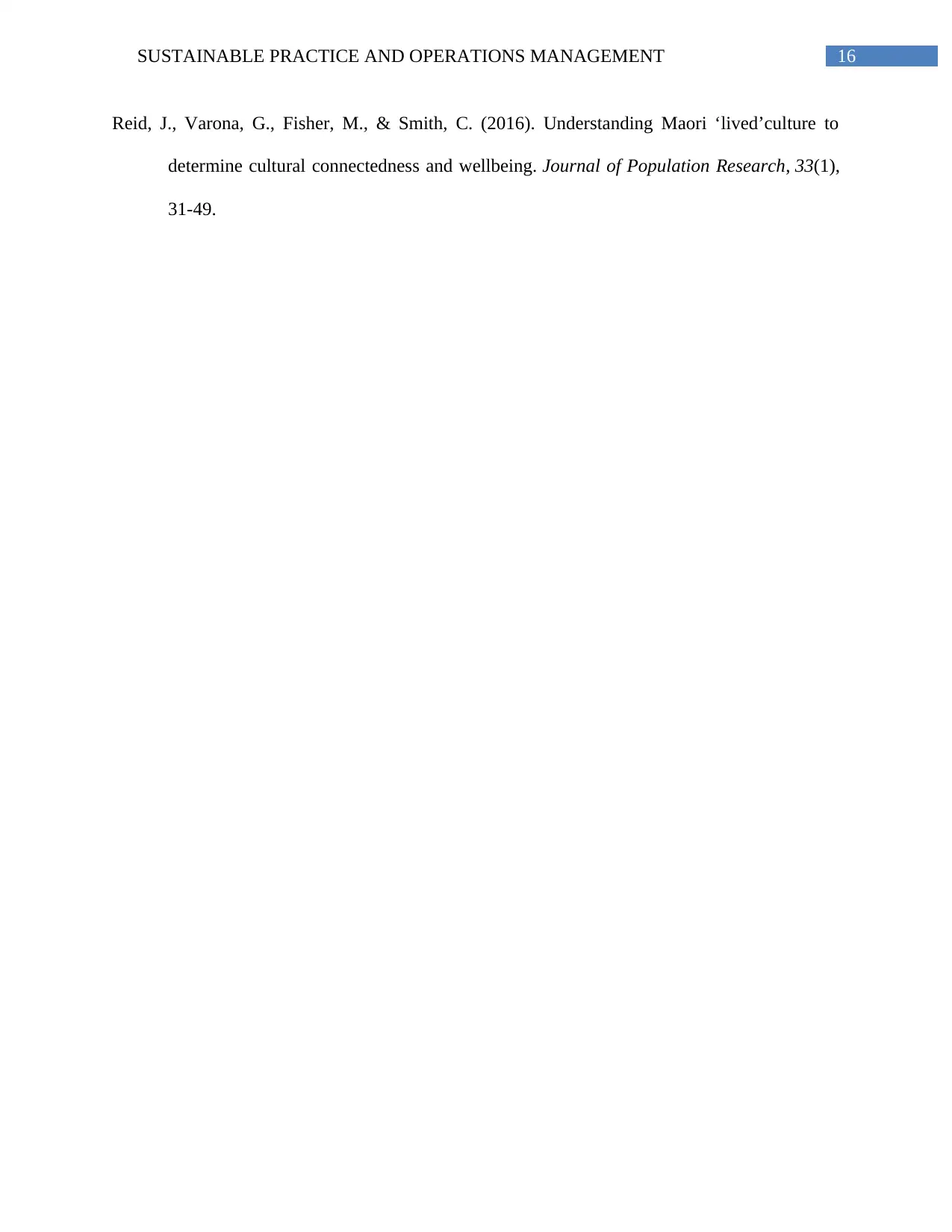
16SUSTAINABLE PRACTICE AND OPERATIONS MANAGEMENT
Reid, J., Varona, G., Fisher, M., & Smith, C. (2016). Understanding Maori ‘lived’culture to
determine cultural connectedness and wellbeing. Journal of Population Research, 33(1),
31-49.
Reid, J., Varona, G., Fisher, M., & Smith, C. (2016). Understanding Maori ‘lived’culture to
determine cultural connectedness and wellbeing. Journal of Population Research, 33(1),
31-49.
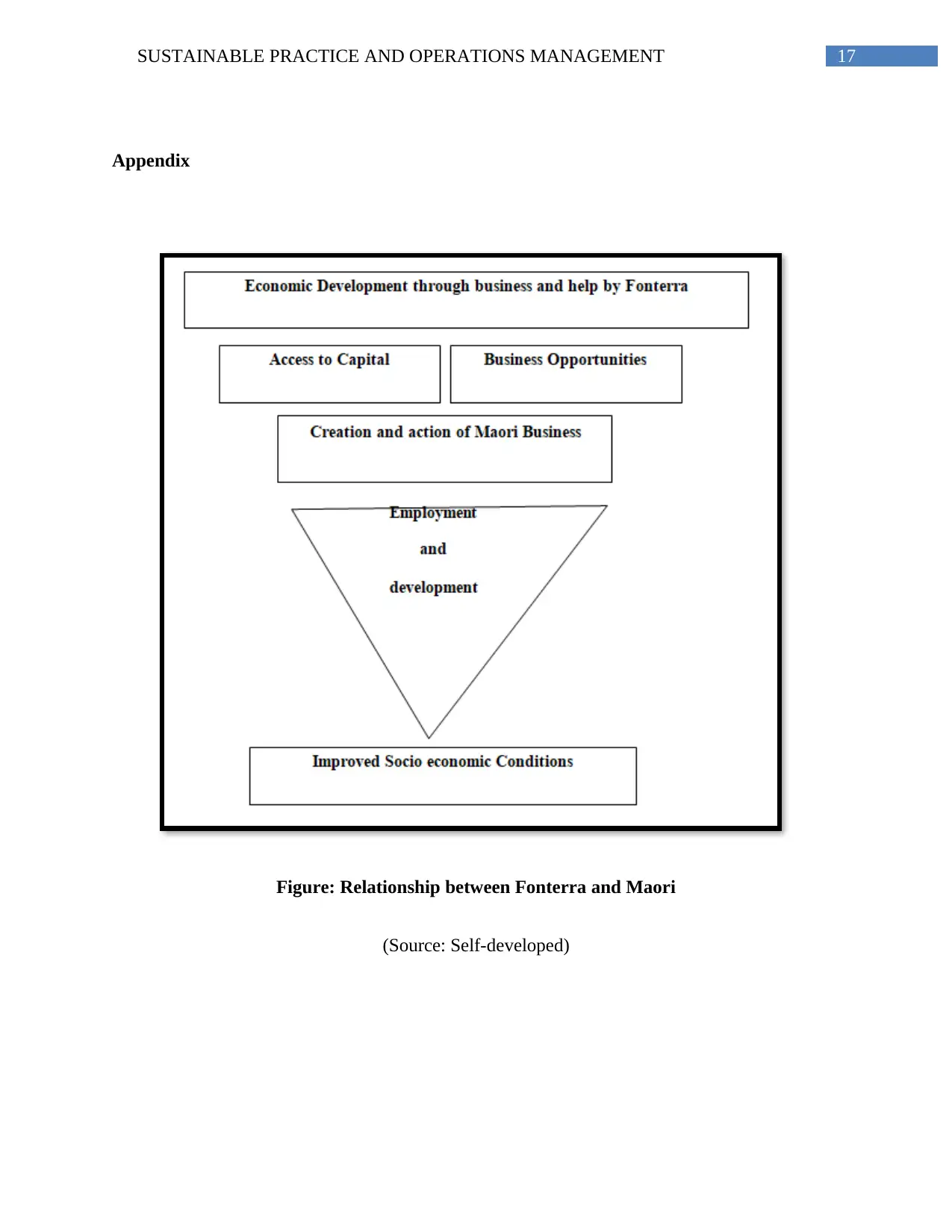
17SUSTAINABLE PRACTICE AND OPERATIONS MANAGEMENT
Appendix
Figure: Relationship between Fonterra and Maori
(Source: Self-developed)
Appendix
Figure: Relationship between Fonterra and Maori
(Source: Self-developed)
1 out of 18
Related Documents
Your All-in-One AI-Powered Toolkit for Academic Success.
+13062052269
info@desklib.com
Available 24*7 on WhatsApp / Email
![[object Object]](/_next/static/media/star-bottom.7253800d.svg)
Unlock your academic potential
© 2024 | Zucol Services PVT LTD | All rights reserved.





